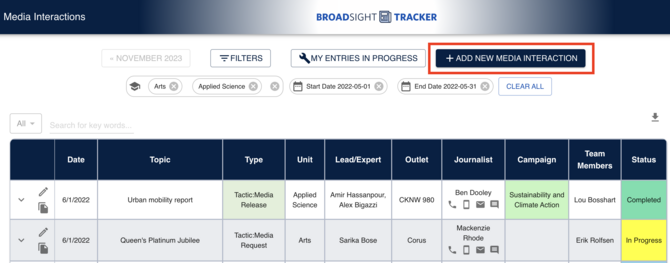Optimizing Your Public Relations Workflow to Achieve Clarity
Picture this: Your PR team is in the thick of a crucial campaign—deadlines closing in, information scattered across channels and pressure steadily mounting.
As organizations grow, planning and executing a unified communications strategy is increasingly essential—and more challenging. It’s no surprise that PR managers at large organizations often find themselves overwhelmed by the multitude of tasks needing coordination.
An efficient public relations workflow is the key to managing these complex and time-sensitive processes. But even today, most public relations teams use a chaotic system. They rely on email exchanges, Google Sheets and general task-management software to manage their workflows. This is inefficient at best. At worst, it invites errors.
Without a streamlined system in place, staying organized and delivering efficient results is an uphill battle. The solution is automation. In a world brimming with digital tools, entrusting routine tasks to technology can empower PR teams to achieve unprecedented efficiency. It simplifies actions, enhances collaboration and frees up time to focus on the more meaningful and strategic aspects of the job.

Mastering Efficiency: Automating Your Public Relations Workflow
Hundreds of digital tools at our disposal today can perform different PR tasks, from press release dissemination to media monitoring and reporting. Individually, each tool eases a different aspect of the public relations function, seemingly improving efficiency and productivity.
But as each platform tackles different bits and pieces of the job, managing such an array of PR tools often adds more complexity.
Dividing your PR workflow across different software tools can lead to a disjointed system, with information scattered all over the place. It’s a barrier to collaboration. PR executives can find themselves juggling data in different formats, or manually transferring information from one tool to another—a time-consuming endeavor that invites errors.
The learning curve for each tool adds another layer of complexity. PR teams invest precious time understanding a tool’s interface and functionality, especially when new features are introduced during updates. Using multiple tools can create redundancies through overlapping functionality, which is a poor use of already limited resources.
Why aren’t public relations tools designed specifically for teams who do this work?
What we truly need is a unified platform—an all-in-one solution that streamlines the most crucial elements of the public relations workflow, simplifies communication about tasks and fosters collaboration. Recognizing this led to the creation of Broadsight Tracker by senior members of the communications team at the University of British Columbia.
Simplifying Your PR Workflow With Broadsight Tracker
Unlike many PR software tools, Broadsight Tracker was designed by media relations leaders specifically for the needs of media relations and issues teams. It is a single-platform public relations tracker for managing all your media interactions, issues, data and reports in one place so your team can stay on top of everything that’s going on.
Here’s how you can streamline your workflow with Broadsight Tracker in five simple steps:
#1: Log Media Interactions as Soon As You Have Them
Every media interaction is a valuable touchpoint. Waiting to log these interactions can lead to missed opportunities, delayed approvals and a fragmented understanding of your true media-engagement efforts.

One of the first things you’ll notice in Broadsight Tracker is a place to jot down key details for new and ongoing media interactions. The 15 seconds it takes to record information promptly fosters accountability within teams, and ensures that no story slips through the cracks.
#2: Centralized Service Log for Project Management
We all know the real work of media teams goes beyond managing media interactions. In fact, many back-end functions like spokesperson training and ‘killing stories’ are arguably the most critical in protecting organizational reputation. Yet, these are the ones we almost always forget to track and report.
Broadsight Tracker has pioneered a simple but powerful “Service Log” interface, where teams can collaborate, assign tasks and track progress on what is being worked on. If offers a bird’s-eye view of every service and its key aspects, including:
- Service Type: From your everyday media Q&As to spokesperson briefings, potential issue flagging, counsel on strategic responses and more. These services are fully customizable to cater to the unique needs of specific organizations.
- Unit: Large organizations often have different departments with varying communications needs. Knowing which facility or department you are serving with any given task can be extremely handy come reporting season.
- Lead / Expert: Different kinds of responses and actions may involve various stakeholders throughout the organization. Tracking this helps your team identify the right point of contact when a similar need arises again.
- Campaign: If your service is part of a larger campaign, linking it back helps highlight the PR team’s contribution to broader organizational goals.
- Team Members: Knowing who’s on point for every action on the team’s agenda ensures that all tasks get done. It’s also useful for knowing which team members are proficient in certain functions for future needs.
- Complexity: No two tasks are equally challenging in a function as dynamic as public relations. Every day, PR managers need to quickly identify and prioritize the most crucial ones.
A centralized dashboard, accessible to everyone on the team, goes a long way in breaking down communication silos and creating a more transparent and efficient workflow.
#3: Maintain a Content Calendar
Consistency is key in PR, and maintaining a content calendar is the secret weapon we all know about. Beyond systemizing ongoing tasks, Broadsight Tracker enables teams to plan, schedule and organize future content seamlessly.
Having a visual representation of your content pipeline will not only ensure a steady flow of communication, but also give PR managers line-of-sight to plan for the upcoming weeks and months.
#4: Your Warm Media Contacts in One Place
Many PR tools offer a database of journalists to contact when you’re ready to pitch. However, these are usually cold leads that your organization has never engaged with. What you really need to land coverage is easy access to your warm contacts—journalists who have covered your stories in the past or have some level of familiarity with your organization.
Once you start diligently logging your media interactions as detailed in Step 1, you’ll find yourself coming across certain names over and over again.
Having quick access to relevant information—when they last engaged with your organization, which pitches they accepted or declined—can arm you to better approach them. Nurturing these connections through personalized engagement will ensure much better success rates for your outreach.
#5: Customized Analytics for Informed PR Strategies
The days of guesswork in public relations are over. Modern PR workflows leverage the power of data to glean valuable insights. Tools like Meltwater or TrendKite go beyond traditional metrics, providing in-depth analysis of media coverage, sentiment and audience engagement. By harnessing data insights, PR professionals can refine strategies and easily measure the real impact of their efforts.
In the dynamic landscape of public relations, achieving clarity is no longer a distant dream, it’s a tangible reality if you have the right digital tools. By centralizing collaboration, automating approvals and embracing analytics, PR professionals can transform their workflows and navigate complex work with finesse.
The journey to clarity begins now. Equip yourself with these digital tools and watch your PR efforts soar.